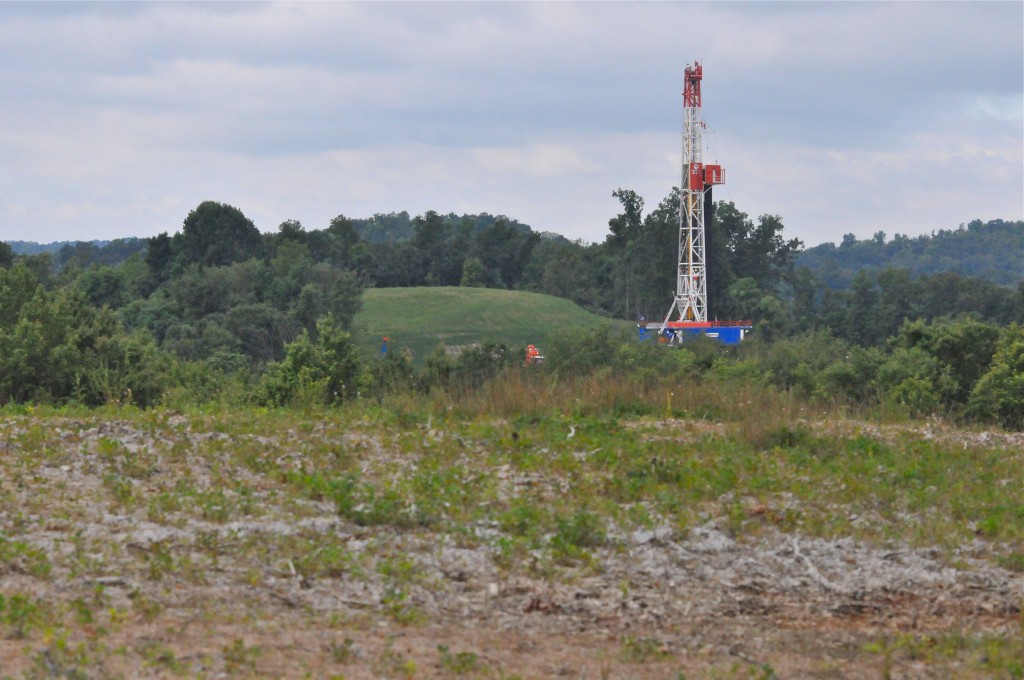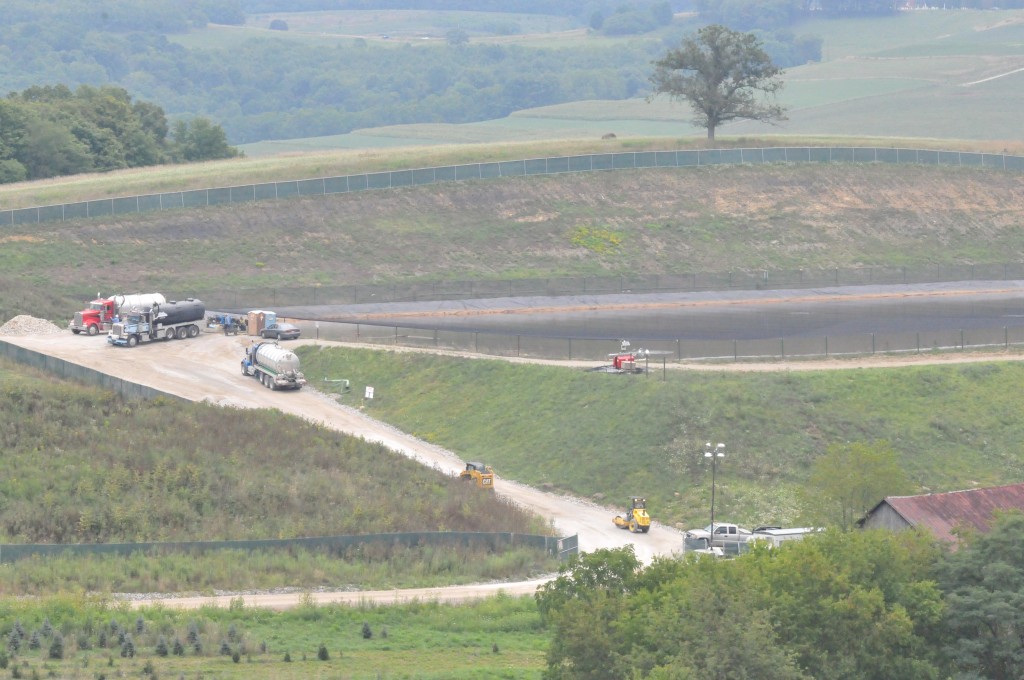Vanessa Lamers is a Joint MESc/MPH Candidate at the Yale School of Forestry and Environmental Studies and the Yale School of Public Health. She spent the summer researching the impacts of shale gas development on water quality in rural southwestern Pennsylvania. Vanessa is the recipient of the 2012 Yale Center for Environmental Law and Policy Research Prize Fellowship for her proposal on hydraulic fracturing.
In Texas in 1999, as the story goes, an inattentive, possibly bored researcher flipped a switch that would change US energy for decades to come. Instead of pumping a specially prepared gel into his test gas well, the researcher accidentally sent down millions of gallons of water. The result of this experiment was the controversial process now discussed daily in newspapers across the country: hydraulic fracturing.
Hydraulic fracturing, commonly known as fracking, is merely one of the many steps involved in extracting natural gas from shale rock deep underground. Fracking uses highly pressurized water, mixed with sand and chemical compounds such as biocides, to break the rock and pipe up the gas. This new technology allows drillers to access unconventional natural gas deposits, like those trapped in shale, driving down energy costs and helping the nation wean itself off coal.
Fracking’s detractors are numerous and vehement. Yet despite numerous reports and lawsuits alleging water, land, and air contamination, as well as animal and human health impacts, shale gas development is growing both domestically and internationally. Despite being banned in places as diverse as France and Vermont, and delayed beneath moratoriums in New York and Maryland, fracking is nonetheless spreading, from Ohio to South Africa.
Hydraulic fracturing, for better or worse, is likely here to stay. But we must also acknowledge that energy extraction confers inherent risks, and discuss how to improve the process. Even if we don’t all agree about whether fracking can be safe, here are five ways it could be made safer:
1) Use alternatives to frac ponds. Impoundment ponds, or “frac” ponds, are essentially open pits that collect the chemical and liquid waste flowing back out of gas wells. Regulations vary widely from state to state about what type of liner, if any, must be laid down to prevent the waste from leaching into the ground. States also disagree about how to eventually dispose of the waste.
Frac ponds are one of the riskiest, least certain aspects of shale drilling: plastic liners leak, rains overflow the ponds’ rims, pets and wild animals fall into ponds, and hazardous chemicals are left to aerate or leach. Impoundment ponds are no longer best practice –– which is why, if fracking commences in New York, the state will require a closed-loop system of tanks, now used by some companies, to deal with the waste.
2) Employ tracing fluids. Currently, there is little courts can do to determine the truth of claims that fracking contaminates waterways. One popular suggestion, proposed by many stakeholders and creative scientists, is to include some type of tracer device, such as a color or a chemical, to follow fracking fluids through the environment.
This solution wouldn’t track the leaching of natural gas through old mines or fissures, but it would help companies, overseers, and policy-makers understand how chemicals flow deep underground, especially when multiple companies are drilling in one area. Such tracers would hold companies accountable to the environment, to landowners, and to stakeholders.
3) Ensure community buy-in. As a Pennsylvanian judge once ruled, municipalities should be able to determine their own character. Cities and regions accomplish this self-determination through zoning laws, giving citizens the power to make informed decisions about the risks and benefits that energy projects bring to their communities. Towns then independently allow or disallow industrial, business or residential zoning in particular areas. However, new laws such as ACT 13 in Pennsylvania and Senate Bill 315 in Ohio strip municipalities of their right to define their own character, and thus prevent them from having a say in the welfare of their own communities.
Forcing industrial processes such as oil and gas drilling onto a community is a lose-lose situation. Residents are disenfranchised and disempowered, and the companies find themselves unwelcome. Complete participation and transparency should be the gold standard, with community members involved in the entire process.
4) Create third-party oversight. Microbac Laboratories, Inc. and Test America, Inc are currently being sued by people who claim their water tests were tampered with — or not released at all — to hide environmental contamination. Whether these claims are true or not, they shine a light on a possible failure in the system: environmental testing is not being conducted by independent third parties.
As a way to protect their residents, some counties require companies to perform pre- and post-tests on well and spring water certain distances from drilling sites. In response, some companies created their own water testing departments or subsidiaries to perform water tests –– a definite conflict of interest.
Somebody besides the gas companies themselves should be testing the water. The obvious choice would be the Department of Environmental Protection. However, some DEP personnel have gone to work for gas companies, and many communities no longer consider them an independent third party.
5) Set strict distances from water sources. In some cases, less than 500 feet separates fracking operations from homes. This is because current zoning laws allow industrial activities to occur in residential areas, permitting companies to prioritize geological estimates and yield over the well-being of households, streams, and wildlife.
Policies and recommendations vary widely about how close shale gas sites should be to lakes, rivers, ponds, houses, wetlands and protected areas. As many counties and states begin to lease or sell land, drill sites are beginning to cross into state or county parks and pass into or through rivers and streams.
Numerous newspaper articles and DEP databases document spills and blowouts near water sources, accidents that affect environmental health downstream and in the immediate vicinity. Forcing drilling operations to keep their distance from water sources will help reduce the risk of environmental contamination.
The technological advances of well drilling into unconventional sources certainly presents economic opportunities. But its consequences are multiple and only now coming into focus. Following the above recommendations, as well as adopting others — like charging companies with capturing methane that leaks from their wells — will help reduce the risks of fracking, even as gas wells spread across the US and the world.
References:
Energy Information Administration (EIA). 2009. Annual Energy Outlook with Projections to 2030. Washington, D.C.: US Department of Energy. http://www.eia.gov/forecasts/aeo/
Wiseman, Hannah Jacobs and Gradijan, Francis, Regulation of Shale Gas Development, Including Hydraulic Fracturing (October 31, 2011). Energy Institute, The University of Texas at Austin, Forthcoming; University of Tulsa Legal Studies Research Paper No. 2011-11. Available at SSRN: http://ssrn.com/abstract=1953547 or http://dx.doi.org/10.2139/ssrn.1953547

